Evolution of the Astonishing Naica Giant Crystals in Chihuahua, Mexico
Abstract
:1. Introduction
2. About Naica
2.1. Water in Naica
2.2. Crystals
3. About Calcium Sulfate as a Crystal
3.1. Structure
3.2. Nucleation and Growth
4. About Research in Naica
4.1. Multidisciplinary Research
4.2. Parallelism with Pulpí Geode
5. Final Remarks
Author Contributions
Funding
Institutional Review Board Statement
Informed Consent Statement
Data Availability Statement
Acknowledgments
Conflicts of Interest
References
- Rickwood, P. The largest crystals. Am. Mineral. 1981, 66, 885–907. [Google Scholar]
- Bromehead, C.E.N. The forgotten uses of selenite. J. Mineral. Soc. 1943, 182, 325–333. [Google Scholar] [CrossRef]
- Szynkiewicz, A.; Ewing, R.C.; Moore, C.H.; Glamoclija, M.; Bustos, D.; Pratt, L.M. Origin of terrestrial gypsum dunes—Implications for Martian gypsum-rich dunes of Olympia Undae. Geomorphology 2010, 121, 69–83. [Google Scholar] [CrossRef]
- Zambonini, F. Mineralogia Vesuviana. In Memorie della Accademia delle Scienze; Reale Accademia delle Scienze Fisiche e Matematiche di Napoli: Napoli, Italy, 1910; Volume 14, pp. 327–328. [Google Scholar]
- Murchie, S.L.; Seelos, F.P.; Hash, C.D.; Humm, D.C.; Malaret, E.; McGovern, J.A.; Choo, T.H.; Seelos, K.D.; Buczkowski, D.L.; Morgan, M.F.; et al. Compact Reconnaissance Imaging Spectrometer for Mars investigation and data set from the Mars Reconnaissance ‘Orbiter’s primary science phase. J. Geophys. Res. 2009, 114, E00D07. [Google Scholar] [CrossRef] [Green Version]
- Bibring, J.P.; Langevin, Y.; Gendrin, A.; Gondet, B.; Poulet, F.; Berthe, M.; Drossart, P. Mars surface diversity as revealed by the OMEGA/Mars Express observations. Science 2005, 307, 1576–1581. [Google Scholar] [CrossRef] [Green Version]
- Stefov, V.; Jovanovski, G.; Shoptrajanov, B.; Mincheva-Shukarova, B.; Dimitrovska, S.; Boev, B. Minerals from Macedonia V Characterization of gypsum, barite, and their synthetic analogues by FTIR and Raman spectroscopy. Geol. Maced. 2000, 14, 61–66. [Google Scholar]
- Bernárdez-Gómez, M.; Guisado-Di Monti, J. Las referencias al lapis specularis en la Historia Natural de Plinio El Viejo. Pallas 2007, 75, 49. Available online: http://www.jstor.org/stable/43606560 (accessed on 16 February 2021).
- Skewes, M.A.; Arévalo, A.; Floody, R.; Zuyiga, P.; Stern, C.R. The giant El Teniente breccia deposit: Hypogene copper distribution and emplacement. In Integrated Methods for Discovery: Global Exploration in the Twenty-First Century; Goldfard, R.J., Nielsen, R.L., Eds.; Society of Economic Geologists, Inc.: Littleton, CO, USA, 2002; Volume 9, pp. 299–332. [Google Scholar]
- Posnjak, E. The system CaSO4-H2O. Am. J. Sci. 1938, 235A, 247–272. [Google Scholar]
- Van Driessche, A.E.S.; Benning, L.G.; Rodriguez-Blanco, J.D.; Ossorio, M.; Bots, P.; García-Ruiz, J.M. The Role and Implications of Bassanite as a Stable Precursor Phase to Gypsum Precipitation. Science 2012, 336, 69–72. [Google Scholar] [CrossRef] [PubMed]
- Van Driessche, A.E.S.; García-Ruiz, J.M.; Delgado-Lopez, J.M.; Sazaki, G.; Delgado-López, J.M.; Sazaki, G.; Sazaki, G. In Situ Observation of Step Dynamics on Gypsum Crystals. Cryst. Growth Des. 2010, 10, 3909–3916. [Google Scholar] [CrossRef]
- Van Driessche, A.E.S.; García-Ruiz, J.M.; Tsukamoto, K.; Patino-López, L.D.; Satoh, H. From the Cover: Ultraslow growth rates of giant gypsum crystals. Proc. Natl. Acad. Sci. USA 2011, 108, 15721–15726. [Google Scholar] [CrossRef] [PubMed] [Green Version]
- Singh, N.B.; Middendorf, B. Calcium sulfate hemihydrate hydration leading to gypsum crystallization. Prog. Cryst. Growth Charact. Mater. 2007, 53, 57–77. [Google Scholar] [CrossRef]
- Pironon, J.; Dubessy, J.; Sterpenich, J.; Robert, P.; Parmentier, M.; Lassin, A.; Randi, A. Dehydration of Gypsum Under Dry CO2 Injection. Energy Procedia 2013, 37, 4575–4582. [Google Scholar] [CrossRef]
- Stone, J.G. Ore genesis in the Naica district, Chihuahua, Mexico. Econ. Geol. 1959, 54, 1002–1034. [Google Scholar] [CrossRef]
- Alva-Valdivia, L.M.; Goguitchaichvili, A.; Urrutia-Fucugauchi, J. Petromagnetic properties in the Naica mining district, Chihuahua, Mexico: Searching for source of mineralization. Earth Planets Space 2003, 55, 19–32. [Google Scholar] [CrossRef] [Green Version]
- Erwood, R.J.; Kesler, S.E.; Cloke, P.L. Compositionally distinct, saline hydrothermal solutions, Naica mine, Chihuahua, Mexico. Econ. Geol. 1979, 74, 95–108. [Google Scholar] [CrossRef]
- Forti, P. Genesis and evolution of the caves in the Naica Mine (Chihuahua, Mexico). Z. Für Geomorphol. 2010, 54 (Suppl. 2), 285–306. [Google Scholar] [CrossRef] [Green Version]
- Marín-Herrera, B.R.; Vogel-González, F.; Echegoyén-Guzman, R. Las megaselenitas del distrito minero de Naica, Chihuahua, una ocurrencia mineralogica anomala. Boletín Mineral. 2006, 17, 139–148. [Google Scholar]
- Briceño-Prieto, S. Caracterización Geoquímica de los Megacristales de Yeso de Naica, Chihuahua y su Relación con los Procesos de Interacción Agua-Roca. Unpublished. Master Thesis, Geology Institute, Universidad Nacional Autónoma de México, Mexico City, Mexico, 2011. Available online: https://ru.dgb.unam.mx/handle/DGB_UNAM/TES01000693286 (accessed on 21 January 2021).
- Trejo-de la Cruz, P. Origen del Agua y Exploración de Yacimientos Minerales en el Distrito Minero de Naica, Edo. de Chihuahua. Mem. Conv. Soc. Geol. Mex. 1971, 1, 273. [Google Scholar]
- Gázquez, F.; Calaforra, J.M.; Stoll, H.; Sanna, L.; Forti, P.; Lauritzen, S.E.; Delgado, A.; Rull, F.; Martínez-Frías, J. Isotope and trace element evolution of the Naica aquifer (Chihuahua, Mexico) over the past 60,000 yr revealed by speleothems. Quat. Res. 2013, 80, 510–521. [Google Scholar] [CrossRef]
- Giulivo, I.; Mecchia, M.; Piccini, P.; Sauro, P. Geology and hydrogeology of Naica. In Le Grotte di Naica: Esplorazione, Documentazione, Ricerca; Forti, P., Ed.; University of Bologna: Bologna, Italy, 2007; pp. 49–50. [Google Scholar]
- De la Torre-Carlos, J.C. Acuífero del yacimiento mineral de Naica. In Memoria Convención; Asociación de Ingenieros de Minas, Metalurgistas y Geólogos de México, A.C.: Chihuahua, Mexico, 1997; Volume 22, p. 149. [Google Scholar]
- Maya-Pacheco, R. Explotación de los Mantos: Tercero, Cuarto y Quinto con Contenidos Económicamente Aprovechables de Tungsteno y Molibdeno en la Unidad Naica, de la Compañía Minera Fresnillo, S.A. de C.V. localizada en Naica, Chihuahua. Unpublished. Bachelor’s Thesis, Engineering School, University of Sonora, Hermosillo, Mexico, 1984. Available online: http://www.bidi.uson.mx/TesisIndice.aspx?tesis=4409 (accessed on 17 February 2021).
- Garofalo, P.S.; Fricker, M.B.; Ganther, D.; Forti, P.; Mercuri, A.M.; Loreti, M.; Capaccioni, B. Climatic control on the growth of gigantic gypsum crystals within hypogenic caves (Naica mine, Mexico)? Earth Planet. Sci. Lett. 2010, 289, 560–569. [Google Scholar] [CrossRef]
- Gázquez, F.; Calaforra, J.M.; Sanna, L.; Forti, P. Espeleotemas de yeso: Un nuevo proxy paleoclimático. Bol. Real Soc. Esp. Hist. Nat. Secc. Geol. 2011, 105, 15–24. [Google Scholar]
- Wayne, M.; Bundy, W.M. Petrology of Gypsum-Anhydrite Deposits in Southwestern Indiana. SEPM J. Sediment. Res. 1956, 26. [Google Scholar] [CrossRef]
- Sanna, L.; Forti, P.; Lauritzen, S.E. Preliminary U-Th dating and the evolution of gypsum crystals in Naica caves (Mexico). Acta Carsol. 2011, 40, 17–28. [Google Scholar] [CrossRef] [Green Version]
- García-Ruiz, J.M.; Villasuso, R.; Ayora, C.; Canals, A.; Otalora, F. The Formation of Gypsum Megacrystals. Geology 2007, 35, 327–330. [Google Scholar] [CrossRef] [Green Version]
- Wittich, E.; Pastor, A.; Giraud, A. Unos cristales gigantes de yeso procedentes de la mina Naica, Chihuahua. Boletín de la Sociedad Geológica Mexicana 1912, 81, 61–70. [Google Scholar] [CrossRef]
- Foshag, W. The selenite caves of Naica. Am. Mineral. 1927, 12, 252–256. [Google Scholar]
- Gázquez, F.; Calaforra, J.; Forti, P.; Rull, F.; Martínez-Frías, J. Gypsum-carbonate speleothems from Cueva de las Espadas (Naica mine, Mexico): Mineralogy and palaeohydrogeological implications. Int. J. Speleol. 2012, 41, 211–220. [Google Scholar] [CrossRef] [Green Version]
- Garofalo, P.S.; Fricker, M.; Günther, D.; Forti, P.; Lauritzen, S.E.; Mercuri, A.M.; Loreti, M. A tale of precipitation and growth of giant selenite crystals within the caves of Naica (Chiuhahua, Mexico). RMS 2008, 158–159. Available online: http://www.minsoc.ru/2008-1-72-1 (accessed on 21 January 2021).
- Forti, P.; Sanna, L. The Naica Project: A multidisciplinary study of the largest gypsum crystals of the world. Episodes 2010, 33, 23–32. [Google Scholar] [CrossRef]
- García-Ruiz, J.M.; Otálora, F. Crystal Growth in Geology: Patterns on the Rocks. In Handbook of Crystal Growth: Bulk Crystal Growth: Second Edition; Elsevier: Amsterdam, The Netherlands, 2015; Volume 2, pp. 1–43. [Google Scholar] [CrossRef]
- Bernabei, T.; Forti, P.; Villasuso, R. Sails: A new gypsum speleothem from Naica, Chihuahua, Mexico. Int. J. Speleol. 2007, 36, 23–30. [Google Scholar] [CrossRef] [Green Version]
- Espino-del Castillo, A.; Beraldi-Campesi, H.; Amador-Lemus, P.; Beltrán, H.I.; Le Borgne, S. Bacterial diversity associated with mineral substrates and hot springs from caves and tunnels of the Naica Underground System (Chihuahua, Mexico). Int. J. Speleol. 2018, 47, 213–227. [Google Scholar] [CrossRef]
- Ragon, M.; Van Driessche, A.E.S.; Garcia-Ruiz, J.M.; Moreira, D.; Lopez-Garcia, P. Microbial diversity in the deep-subsurface hydrothermal aquifer feeding the giant gypsum crystal-bearing Naica mine, Mexico. Front. Microbiol. 2013, 4, 37. [Google Scholar] [CrossRef] [PubMed] [Green Version]
- Holden, C. Life in crystal. Science 2008, 319, 391a. [Google Scholar] [CrossRef]
- Bishop, J.; Lane, M.; Dyar, D.; King, S.; Brown, A.; Swayze, G. Ca-sulfate’s spectral properties: Gypsum, bassanite, and anhydrite. Am. Mineral. 2014, 99, 2105–2115. [Google Scholar] [CrossRef]
- Christensen, A.N.; Olesen, M.; Cerenius, Y.; Jensen, T.R. Formation and Transformation of Five Different Phases in the CaSO4-H2O System: Crystal Structure of the Subhydrate β-CaSO4-0.5H2O and Soluble Anhydrite CaSO4. Chem. Mater. 2008, 20, 2124–2132. [Google Scholar] [CrossRef]
- Van Rosmalen, G.M.; Daudey, P.J.; Marchée, W.G.J. An analysis of growth experiments of gypsum crystals in suspension. J. Cryst. Growth 1981, 52, 801–811. [Google Scholar] [CrossRef]
- Hawthorne, F.C.; Krivovichev, S.V.; Burns, P.C. The Crystal Chemistry of Sulfate Minerals. Rev. Mineral. Geochem. 2000, 40, 1–112. [Google Scholar] [CrossRef]
- Kuzel, H.J.; Hauner, M. Chemical and crystallographical properties of calcium sulfate hemihydrate and anhydrite III. ZKG, Zement-Kalk-Gips Edition A 1987, 40, 628–632. [Google Scholar]
- Hildyard, R.C.; Llana-Funez, S.; Wheeler, J.; Faulkner, D.R.; Prior, D.J. Electron Backscatter Diffraction (EBSD) Analysis of Bassanite Transformation Textures and Crystal Structure Produced from Experimentally Deformed and Dehydrated Gypsum. J. Petrol. 2011, 52, 839–856. [Google Scholar] [CrossRef]
- Ballirano, P.; Maras, A.; Meloni, S.; Caminiti, R. The monoclinic I2 structure of bassanite, calcium sulphate hemihydrate (CaSO4·0.5H2O). Eur. J. Mineral. 2001, 13, 956–993. [Google Scholar] [CrossRef]
- Bushuev, N.N.; Borisov, V.M. X-ray-diffraction study of CaSO4·0,67H2O. Zhurnal Neorganicheskoi Khimii 1982, 27, 604–609. [Google Scholar]
- Gallitelli, P. Ricerche sul solfato di calcio semidrato e sull’anidrite solubile. Period. Min. Roma 1933, 4, 1–42. [Google Scholar]
- Bezou, C.; Nonat, A.; Mutin, J.C.; Christensen, A.N.; Lehmann, M.S. Investigation of the crystal structure of γ-CaSO4, CaSO4·0.5 H2O, and CaSO4·0.6 H2O by powder diffraction methods. J. Solid State Chem. 1995, 117, 165–176. [Google Scholar] [CrossRef]
- Abriel, W. Calcium sulfat subhydrat, CaSO4. 0, 8H2O. Acta Crystallogr. Sect. C Cryst. Struct. Commun. 1983, 39, 956–958. [Google Scholar] [CrossRef]
- Follner, S.; Wolter, A.; Preusser, A.; Indris, S.; Silber, C.; Follner, H. The Setting Behaviour of α- and β-CaSO4·0,5 H2O as a Function of Crystal Structure and Morphology. Cryst. Res. Technol. 2002, 37, 1075–1087. [Google Scholar] [CrossRef]
- Kelley, K.K.; Southard, J.C.; Anderson, C.T. Thermodynamic Properties of Gypsum and Its Dehydration Products; US Government Printing Office: Washington, DC, USA, 1941; Volume 625, p. 71. [Google Scholar]
- Otalora, F.; Garcia-Ruiz, J.M. Nucleation and growth of the Naica giant gypsum crystals. Chem. Soc. Rev. 2014, 43, 2013–2026. [Google Scholar] [CrossRef]
- Ossorio, M.; Van Driessche, A.E.S.; Pérez, P.; García-Ruiz, J.M. The gypsum–anhydrite paradox revisited. Chem. Geol. 2014, 386, 16–21. [Google Scholar] [CrossRef]
- Barbier, E.; Coste, M.; Genin, A.; Jung, D.; Lemoine, C.; Logette, S.; Muhr, H. Simultaneous determination of nucleation and crystal growth kinetics of gypsum. Chem. Eng. Sci. 2009, 64, 363–369. [Google Scholar] [CrossRef]
- Reiss, A.G.; Gavrieli, I.; Rosenberg, Y.O.; Reznik, I.J.; Luttge, A.; Emmanuel, S.; Ganor, J. Gypsum Precipitation under Saline Conditions: Thermodynamics, Kinetics, Morphology, and Size Distribution. Minerals 2021, 11, 141. [Google Scholar] [CrossRef]
- Reznik, I.J.; Ganor, J.; Gruber, C.; Gavrieli, I. Towards the establishment of a general rate law for gypsum nucleation. Geochim. Cosmochim. Acta 2012, 85, 75–87. [Google Scholar] [CrossRef]
- Rendel, P.M.; Gavrieli, I.; Wolff-Boenisch, D.; Ganor, J. Towards establishing a combined rate law of nucleation and crystal growth—The case study of gypsum precipitation. J. Cryst. Growth 2018, 485, 28–40. [Google Scholar] [CrossRef]
- Kashchiev, D. Nucleation; Oxford, Butterworth-Heinemann, Elsevier: Oxford, UK, 2000. [Google Scholar]
- Vekilov, P.G. Nucleation. Cryst. Growth Des. 2010, 10, 5007–5019. [Google Scholar] [CrossRef]
- Saha, A.; Lee, J.; Pancera, S.M.; Bräeu, M.F.; Kempter, A.; Tripathi, A.; Bose, A. New Insights into the Transformation of Calcium Sulfate Hemihydrate to Gypsum Using Time-Resolved Cryogenic Transmission Electron Microscopy. Langmuir 2012, 28, 11182–11187. [Google Scholar] [CrossRef]
- Jones, F. Infrared investigation of barite and gypsum crystallization: Evidence for an amorphous to crystalline transition. Cryst. Eng. Comm. 2012, 14, 8374–8381. [Google Scholar] [CrossRef] [Green Version]
- Ossorio, M.; Stawski, T.M.; Rodríguez-Blanco, J.D.; Sleutel, M.; García-Ruiz, J.M.; Benning, L.G.; Van Driessche, A.E.S. Physicochemical and Additive Controls on the Multistep Precipitation Pathway of Gypsum. Minerals 2017, 7, 140. [Google Scholar] [CrossRef] [Green Version]
- He, K.; Nie, A.; Yuan, Y.; Ghodsi, S.M.; Song, B.; Firlar, E.; Lu, J.; Lu, Y.; Shokuhfar, T.; Megaridis, C.M.; et al. In Situ Transmission Electron Microscopy Explores a New Nanoscale Pathway for Direct Gypsum Formation in Aqueous Solution. ACS Appl. Nano Mater. 2018, 1, 5430–5440. [Google Scholar] [CrossRef]
- Stawski, T.M.; Benning, L.G. Chapter Five—SAXS in Inorganic and Bioinspired Research. In Research Methods in Biomineralization Science; Academic Press: Cambridge, MA, USA, 2013; Volume 532, pp. 95–127. [Google Scholar] [CrossRef]
- Stawski, T.M.; Freeman, H.M.; Van Driessche, A.E.S.; Hövelmann, J.; Besselink, R.; Wirth, R.; Benning, L.G. Particle-Mediated Nucleation Pathways Are Imprinted in the Internal Structure of Calcium Sulfate Single Crystals. Cryst. Growth Des. 2019, 7, 3714–3721. [Google Scholar] [CrossRef] [Green Version]
- Van Driessche, A.E.S.; Stawski, T.M.; Kellermeier, M. Calcium sulfate precipitation pathways in natural and engineered environments. Chem. Geol. 2019, 530, 2019–119274. [Google Scholar] [CrossRef]
- Hardie, L.A. The gypsum-anhydrite equilibrium at one atmosphere pressure. Am. Mineral. 1967, 52, 171–200. [Google Scholar]
- Robie, R.A.; Hemingway, B.S.; Fisher, J.R. Thermodynamic properties of minerals and related substances at 298.15 K and 1 Bar (105 Pascals) pressure and at higher temperatures. Geol. Surv. Bull. 1978, 1452, 1–456. [Google Scholar]
- Krüger, Y.; García-Ruiz, J.M.; Canals, A.; Marti, D.; Frenz, M.; Van Driessche, A.E.S. Determining gypsum growth temperatures using monophase fluid inclusions-Application to the giant gypsum crystals of Naica, Mexico. Geology 2013, 41, 119–122. [Google Scholar] [CrossRef] [Green Version]
- Sanna, L.; Saez, F.; Simonsen, S.; Constantin, S.; Calaforra, J.M.; Forti, P.; Lauritzen, S.E. Uranium-series dating of gypsum speleothems: Methodology and examples. Int. J. Speleol. 2010, 39, 35–46. [Google Scholar] [CrossRef] [Green Version]
- Carreño-Márquez, I.J.A.; Castillo-Sandoval, I.; Esparza-Ponce, H.E.; Fuentes-Cobas, L.; Montero-Cabrera, M.E. Characterization of gypsum crystals exposed to a high CO2 concentration fog using X-ray. In Proceedings of the AIP Conference, Ciudad Juárez, Mexico, 4–6 March 2015; Volume 1671. [Google Scholar] [CrossRef] [Green Version]
- Castillo-Sandoval, I.; Fuentes-Cobas, L.E.; Fuentes-Montero, M.E.; Esparza-Ponce, H.E.; Carreño-Márquez, J.; Reyes-Cortes, M.; Montero-Cabrera, M.E. Light in the Darkening on Naica Gypsum Crystals. Xi Int. Symp. Radiat. Phys. 2015, 1671, 30005–30009. [Google Scholar] [CrossRef] [Green Version]
- Castillo-Sandoval, I.; Fuentes-Cobas, L.E.; Pérez-Cazares, B.E.; Esparza-Ponce, H.E.; Fuentes-Montero, M.E.; Castillo-Michel, H.; Eichert, D.; Reyes-Cortes, I.; Carreño-Márquez, I.J.; Nápoles-Duarte, J.M.; et al. Surface impurities on giant gypsum crystals from “la Cueva de las Espadas” (Cave of Swords), Naica, Mexico. Mineral. Petrol. 2018, 112. [Google Scholar] [CrossRef]
- Carreño-Marquez, I.J.A.; Menéndez-Méndez, E.; Esparza-Ponce, H.E.; Fuentes-Cobas, L.; García-Rovés, R.; Castillo-Sandoval, I.; Luna-Porres, M.; De-Frutos-Vaquerizo, J.; Montero-Cabrera, M.E. Naica’s Giant Crystals: Deterioration Scenarios. Cryst. Growth Des. 2018, 18. [Google Scholar] [CrossRef]
- Auvray, C.; Homand, F.; Sorgi, C. The aging of gypsum in underground mines. Eng. Geol. 2004, 74, 183–196. [Google Scholar] [CrossRef]
- Gázquez, F.; Badino, G.; Calaforra, J.M.; Forti, P. Estrategias de conservación de los cristales gigantes de yeso. In Cuevatur 2014; Calaforra, J.M., Duran, J.J., Eds.; Asociación de Cuevas Turísticas Españolas: Aracena, Spain, 2014; pp. 29–39. [Google Scholar]
- Forti, P. What Will Be the Future of the Giant Gypsum Crystals of Naica Mine? In Geological Society Special Publication; Geological Society of London: London, UK, 2017; Volume 1, pp. 461–475. [Google Scholar] [CrossRef]
- Gázquez, F.; Calaforra, J.M.; Forti, P.; Badino, G. The caves of Naica: A decade of Research. Bol. Geol. Y Min. 2016, 127, 147–163. [Google Scholar]
- Montero-Cabrera, M.E.; Carreño-Márquez, I.; Castillo-Sandoval, I.; Pérez-Cázares, B.; Fuentes-Cobas, L.E.; Esparza-Ponce, H.E.; Menéndez-Méndez, E.; Fuentes-Montero, M.E.; Castillo-Michel, H.; Eichert, D.; et al. Are the Naica giant crystals deteriorating because of human action? Powder Diffr. 2020, 35, S15–S23. [Google Scholar] [CrossRef]
- Badino, G. The Cueva de los Cristales micrometeorology. In Proceedings of the 15th International Congress of Speleology, Kerrville, TX, USA, 19–26 July 2009; Volume 3, pp. 1407–1412. [Google Scholar]
- Badino, G.; Calaforra, J.M.; Forti, P.; Garofalo, P.; Sanna, L. The present day genesis and evolution of cave minerals inside the Ojo de la Reina Cave (Naica Mine, Mexico). Int. J. Speleol. 2011, 40, 125–131. [Google Scholar] [CrossRef] [Green Version]
- Fernández-Cortes, A.; Calaforra, J.; García-Guinea, J. The Pulpi gigantic geode (Almeria, Spain): Geology, metal pollution, microclimatology, and conservation. Environ. Geol. 2006, 50, 707–716. [Google Scholar] [CrossRef]
- Garcia-Guinea, J.; Morales, S.; Delgado, A.; Recio, C.; Calaforra, J.M. Formation of gigantic gypsum crystals. J. Geol. Soc. 2002, 159, 347–350. [Google Scholar] [CrossRef]
- Canals, A.; Van Driessche, A.E.S.; Palero, F.; García-Ruiz, J.M. The origin of large gypsum crystals in the Geode of Pulpí (Almería, Spain). Geology 2019, 47, 1161–1165. [Google Scholar] [CrossRef]
- Forti, P.; Onac, B.P. Caves and mineral deposits. Zeitschrift Geomorphol. 2016, 60, 57–102. [Google Scholar] [CrossRef]
- Iriarte, E.; Sánchez, M.A.; Foyo, A.; Tomillo, C. Geological risk assessment for cultural heritage conservation in karstic caves. J. Cult. Herit. 2010, 11, 250–258. [Google Scholar] [CrossRef]
- Dragovich, D.; Grose, J. Impact of tourists on carbon dioxide levels at Jenolan Caves, Australia: An examination of microclimatic constraints on tourist cave management. Geoforum 1990, 21, 111–120. [Google Scholar] [CrossRef]
- Šebela, S.; Turk, J. Sustainable use of the Predjama Cave (Slovenia) and possible scenarios related to anticipated major increases in tourist numbers. Tour. Manag. Perspect. 2014, 10, 37–45. [Google Scholar] [CrossRef]
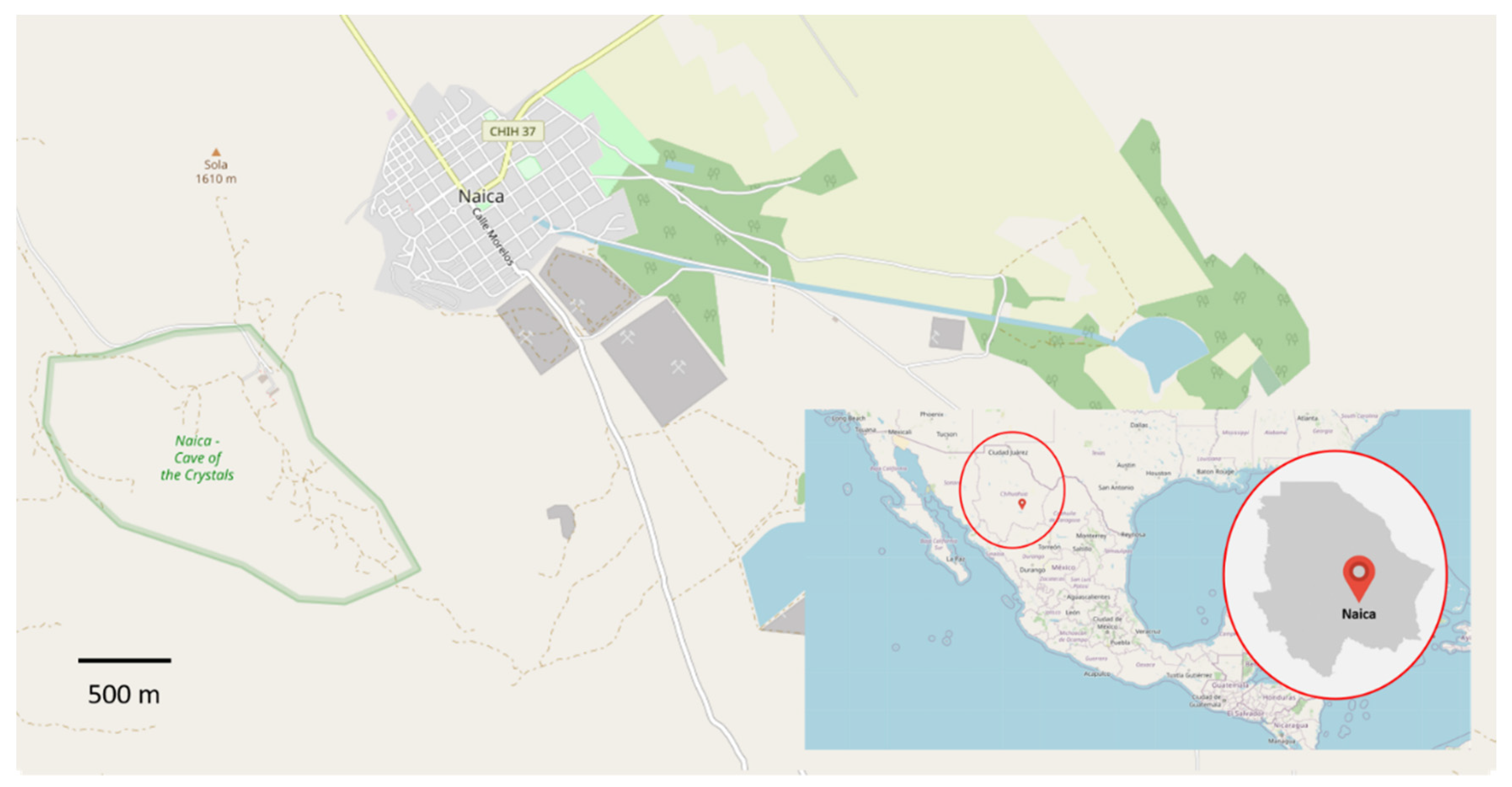
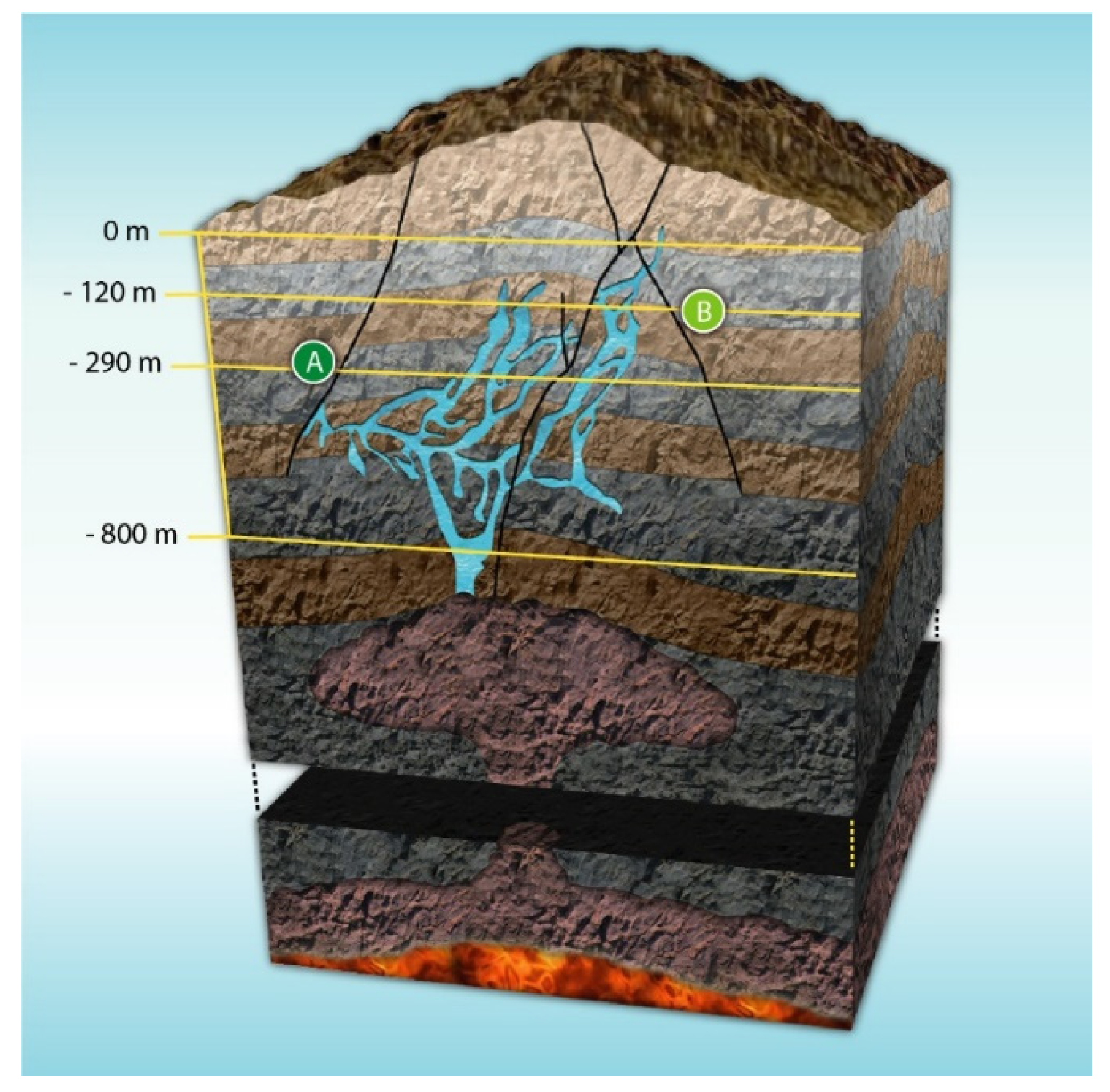
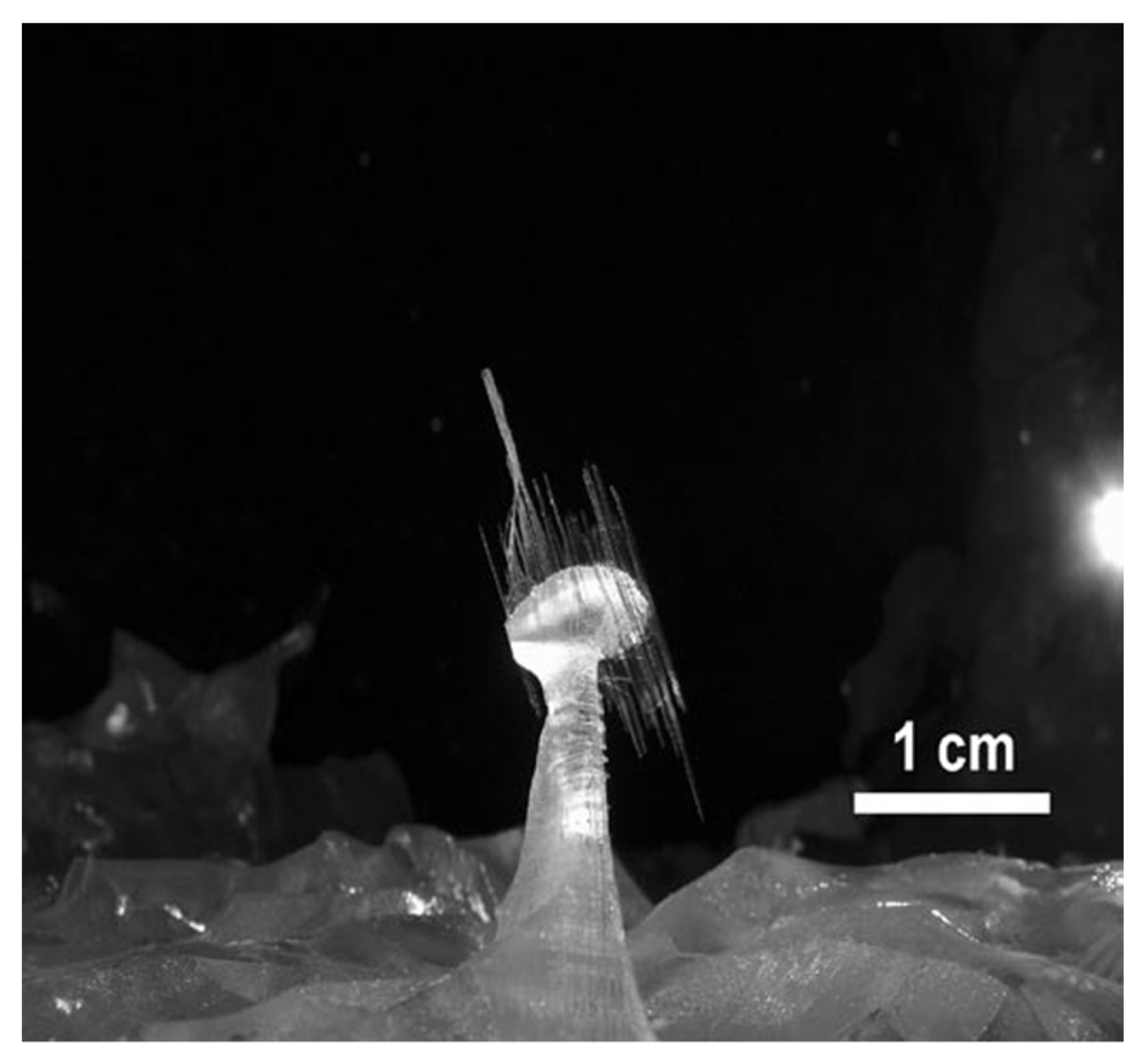
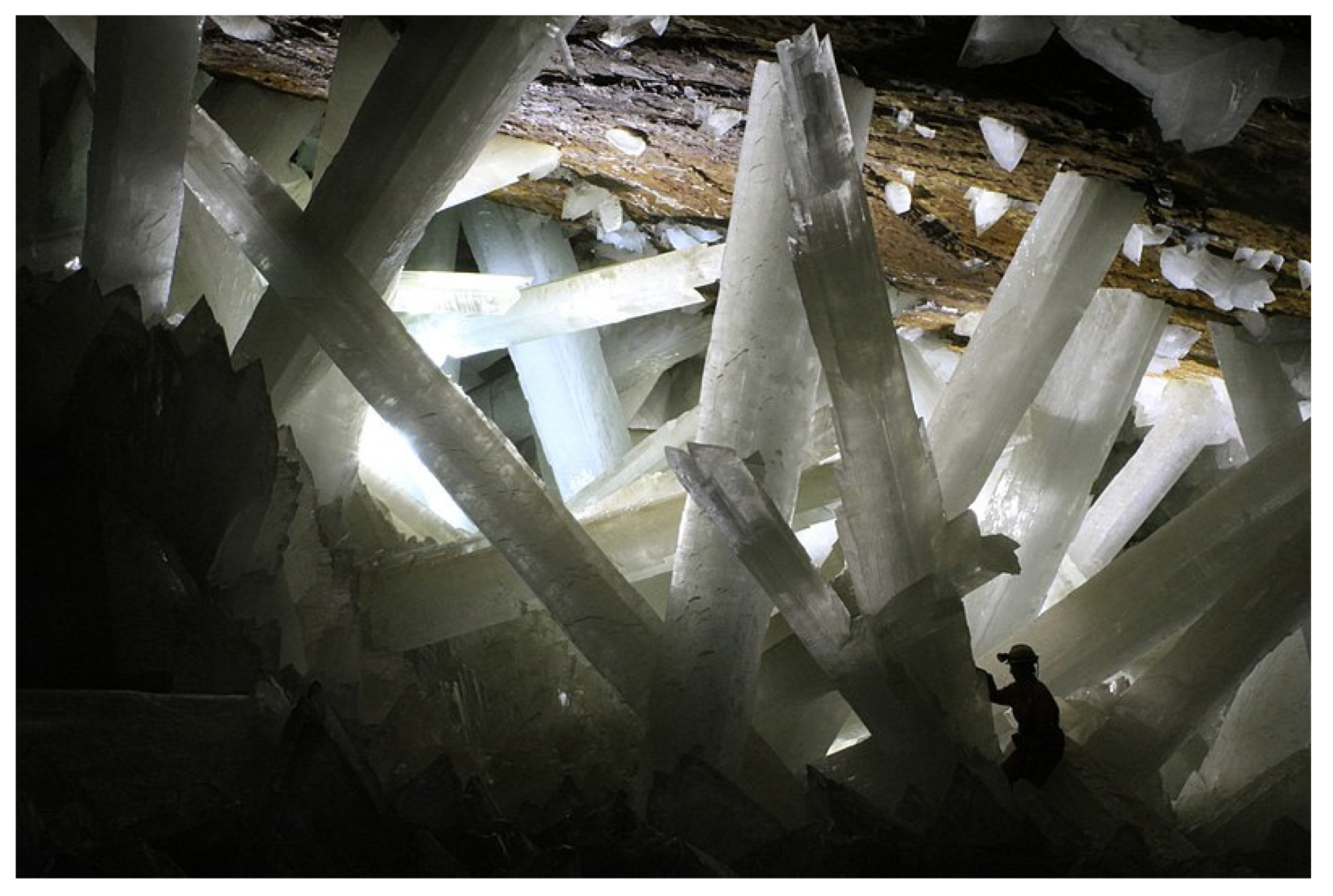
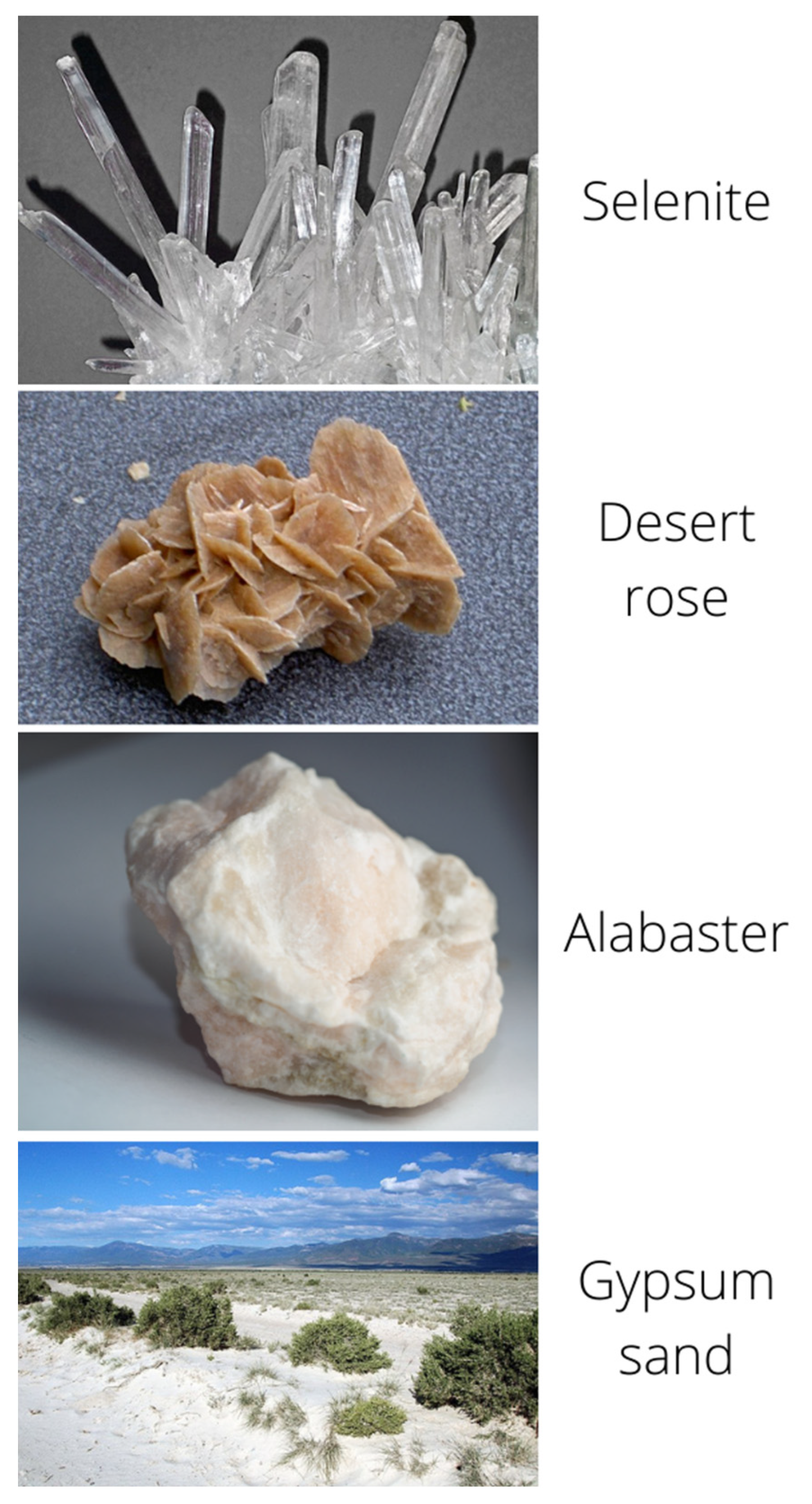
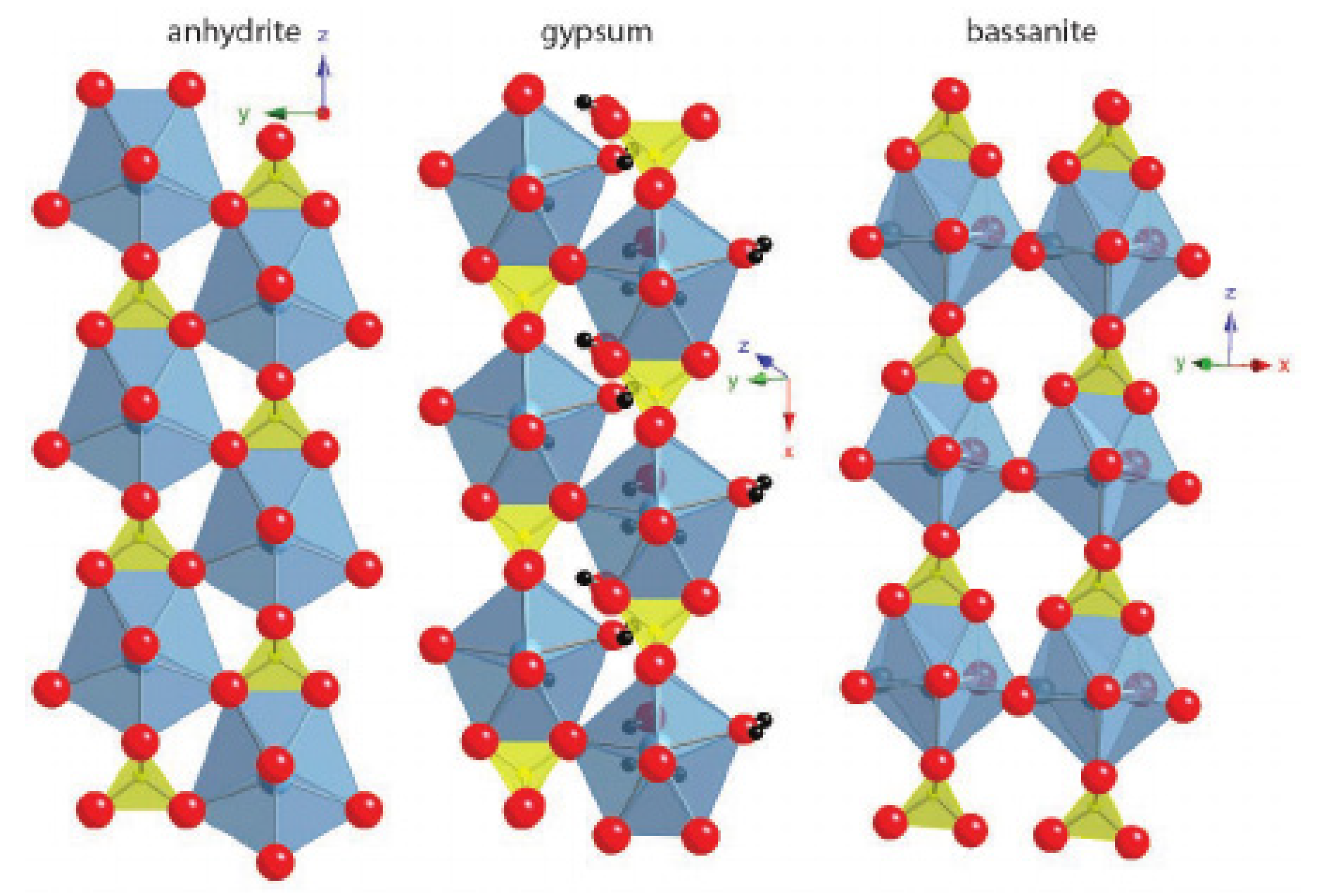
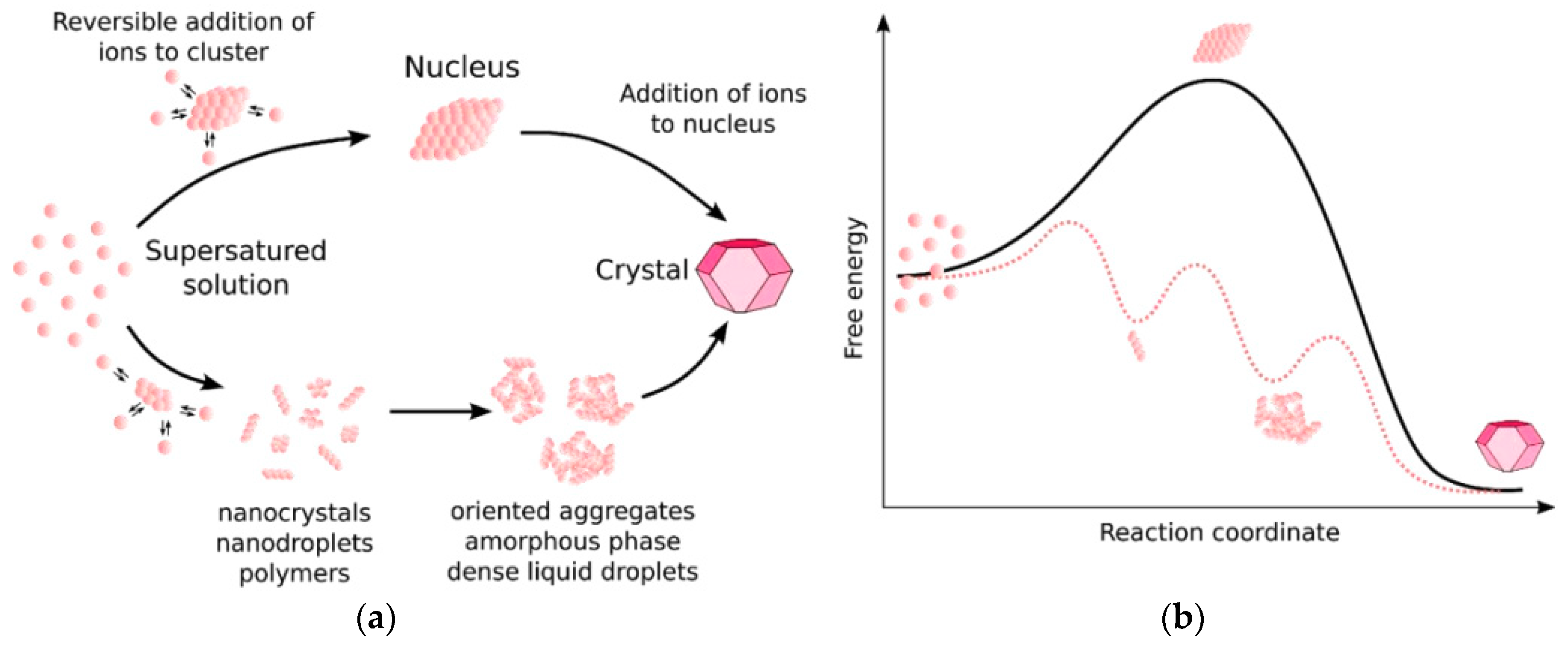
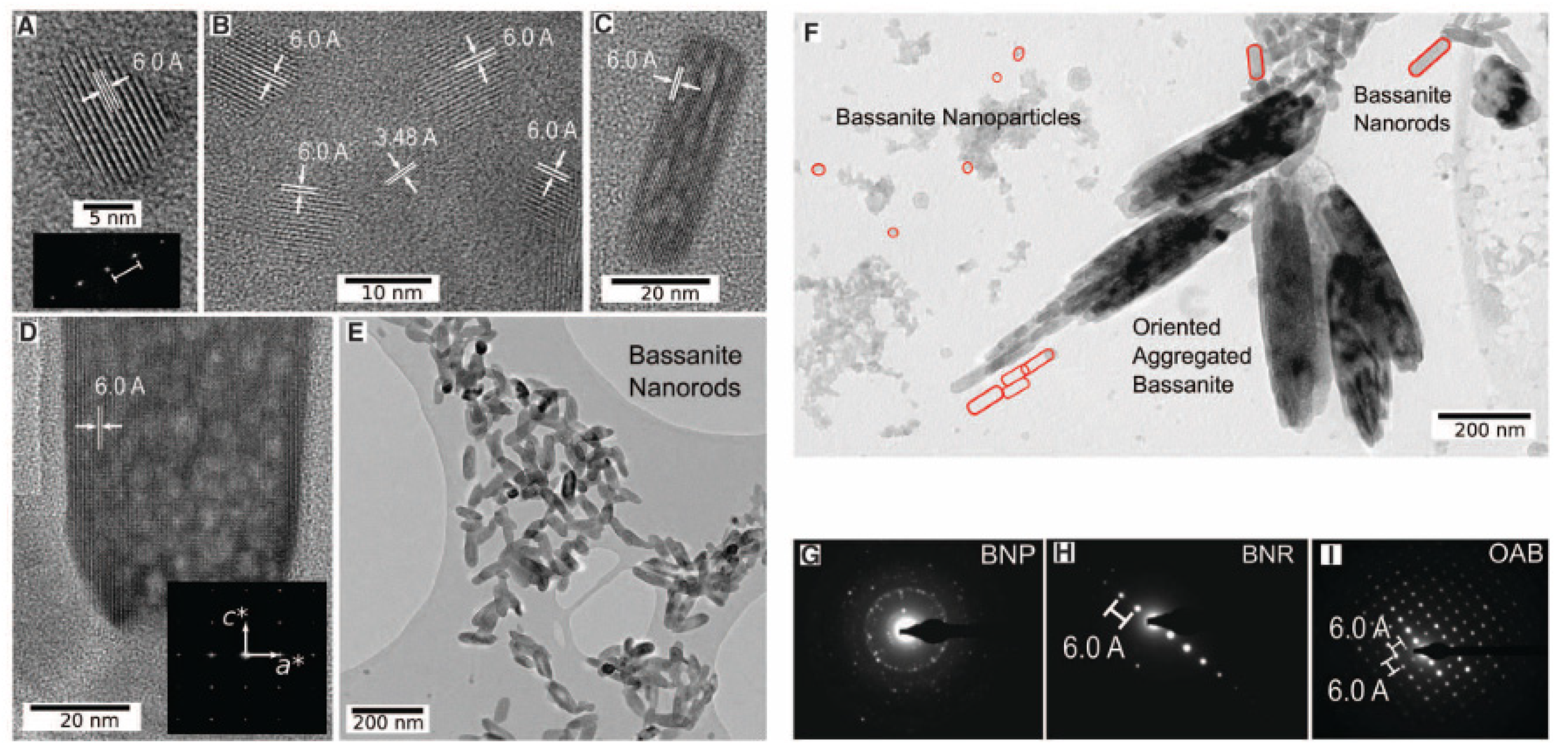
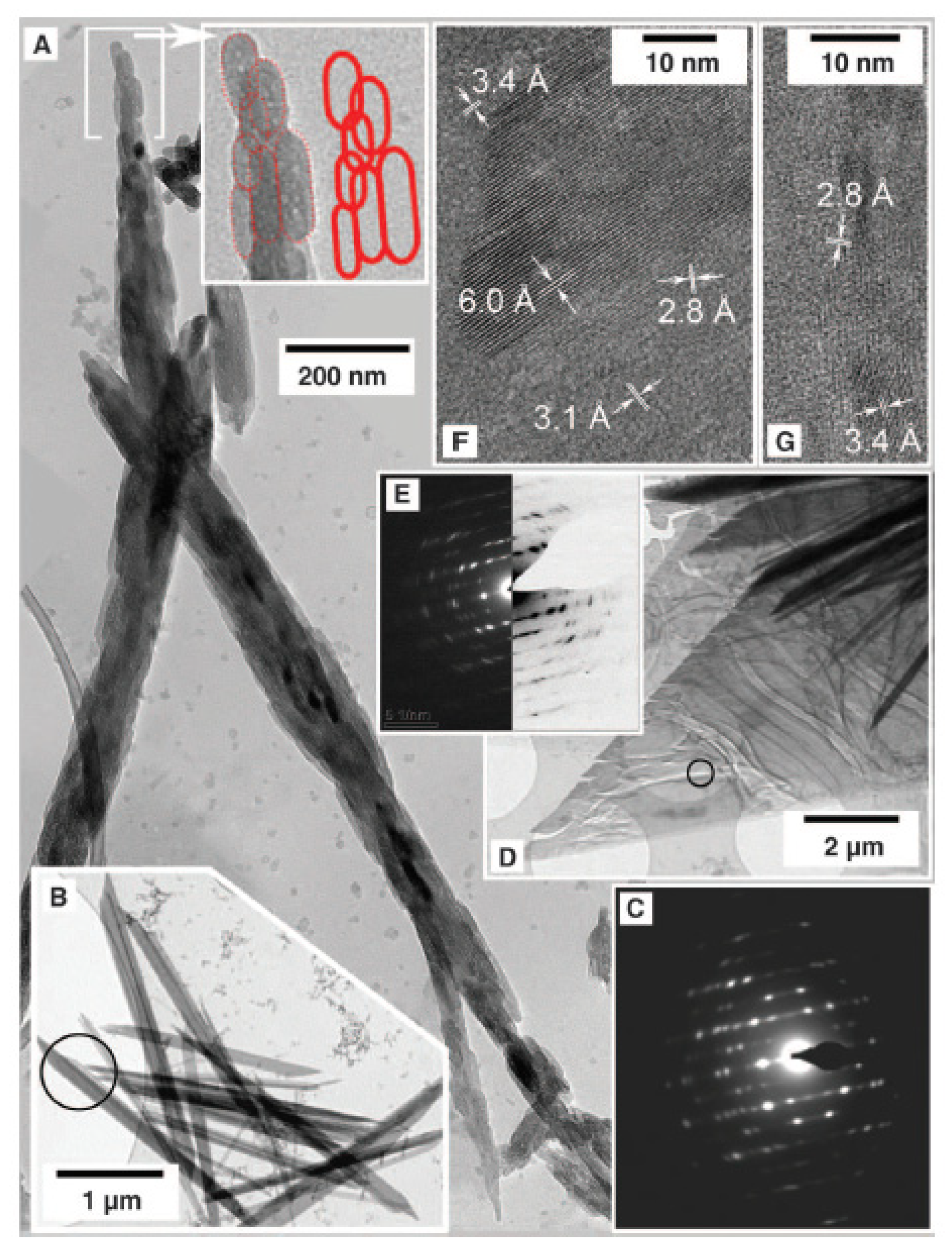
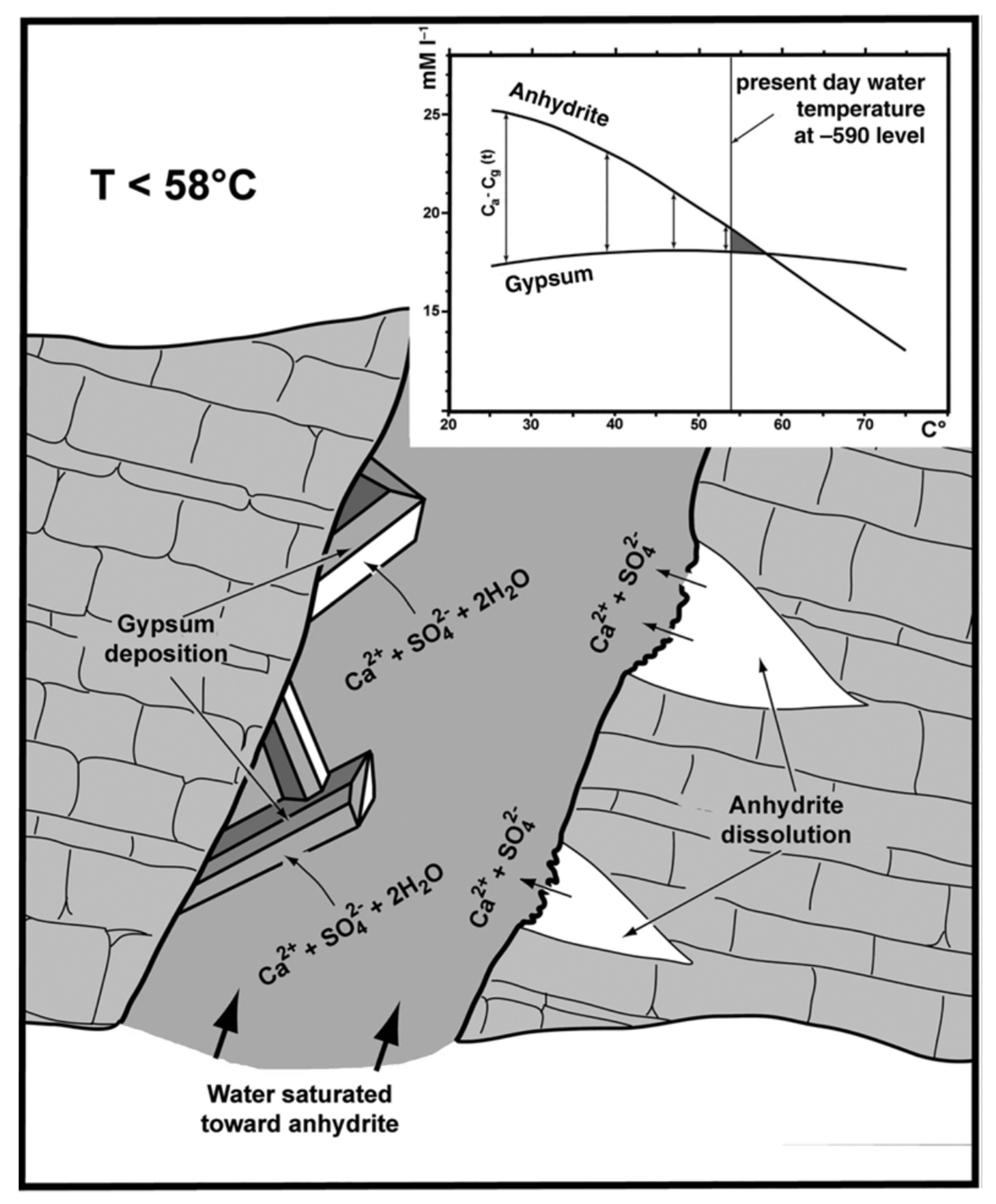
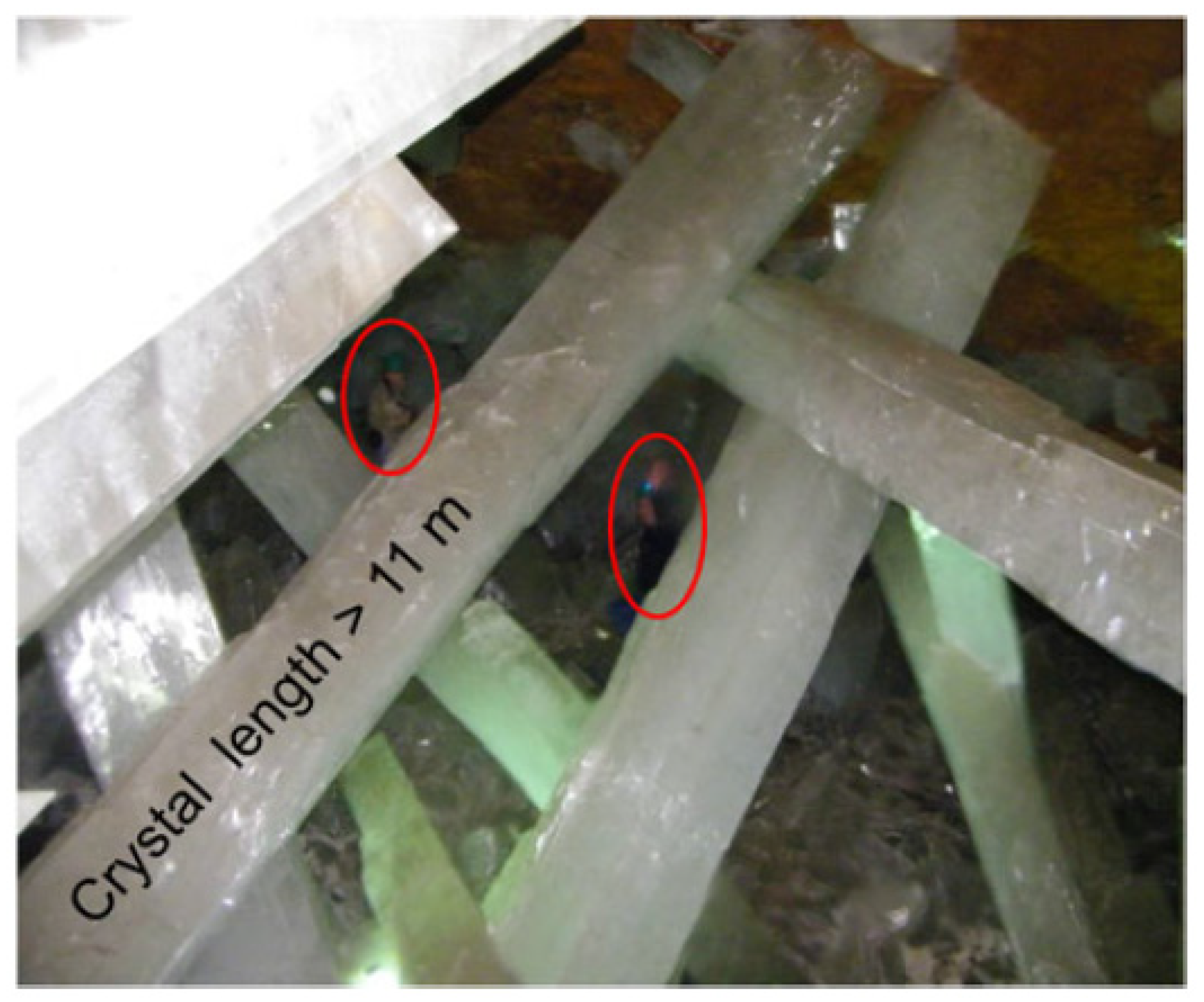
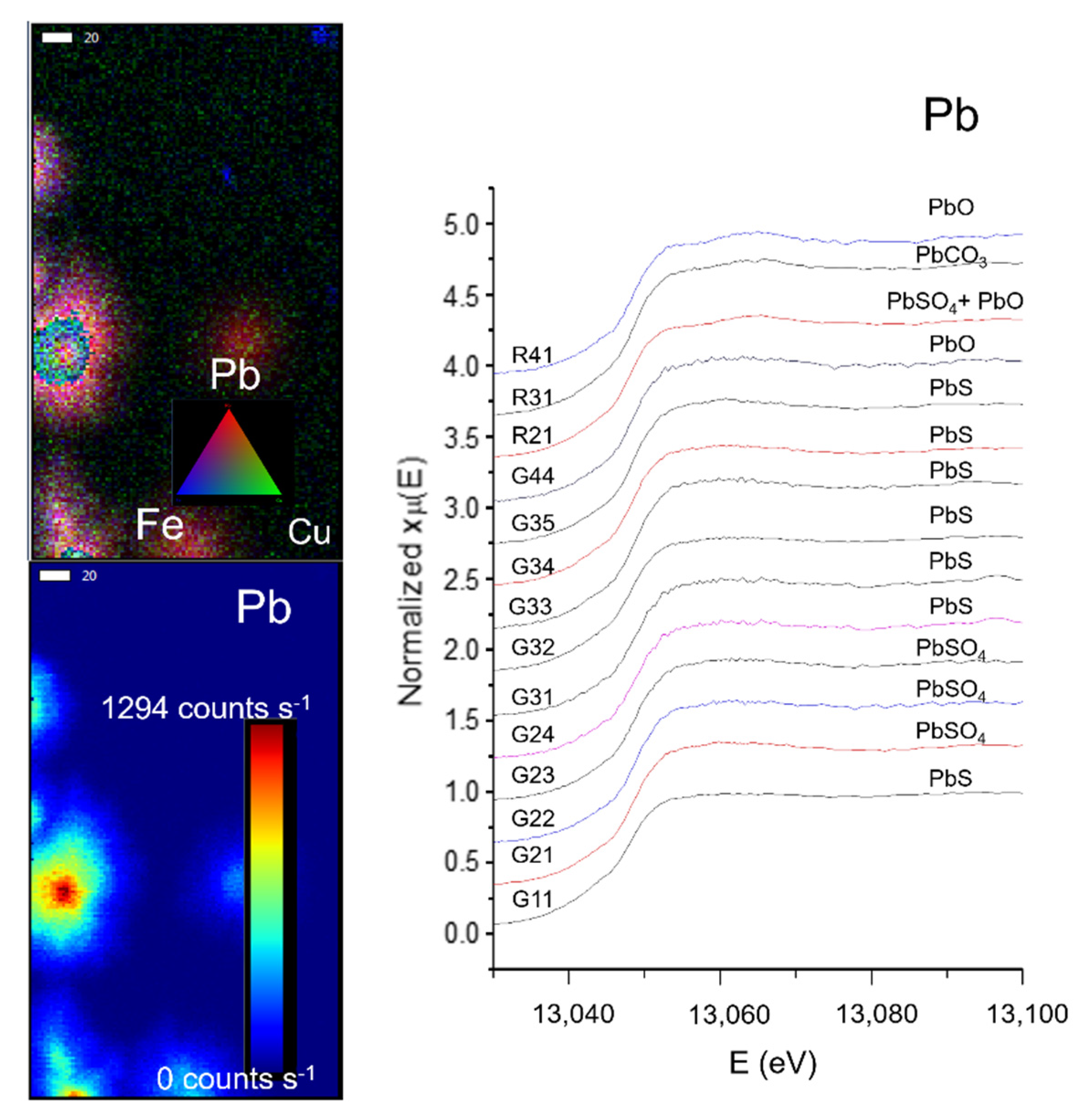
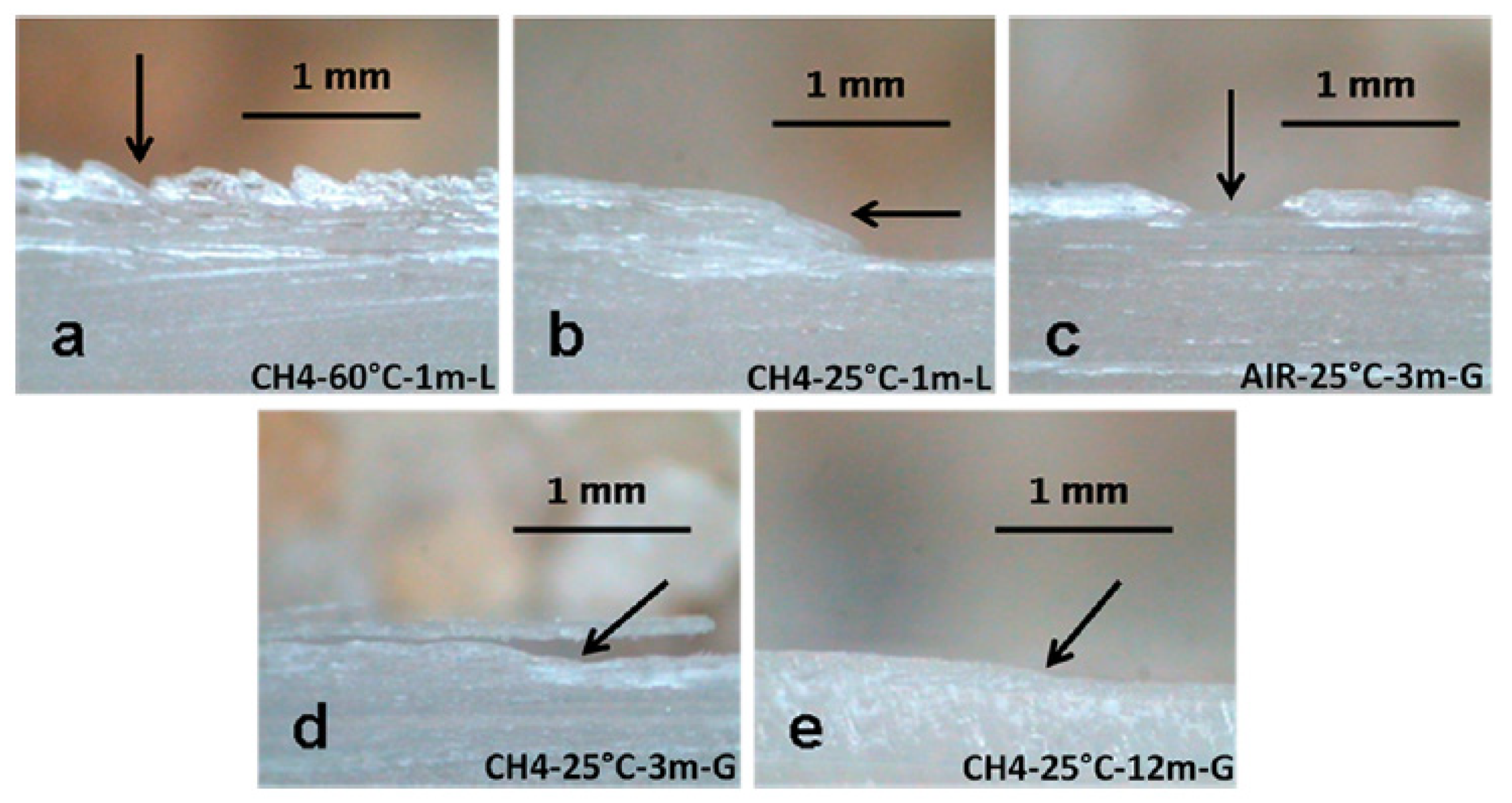
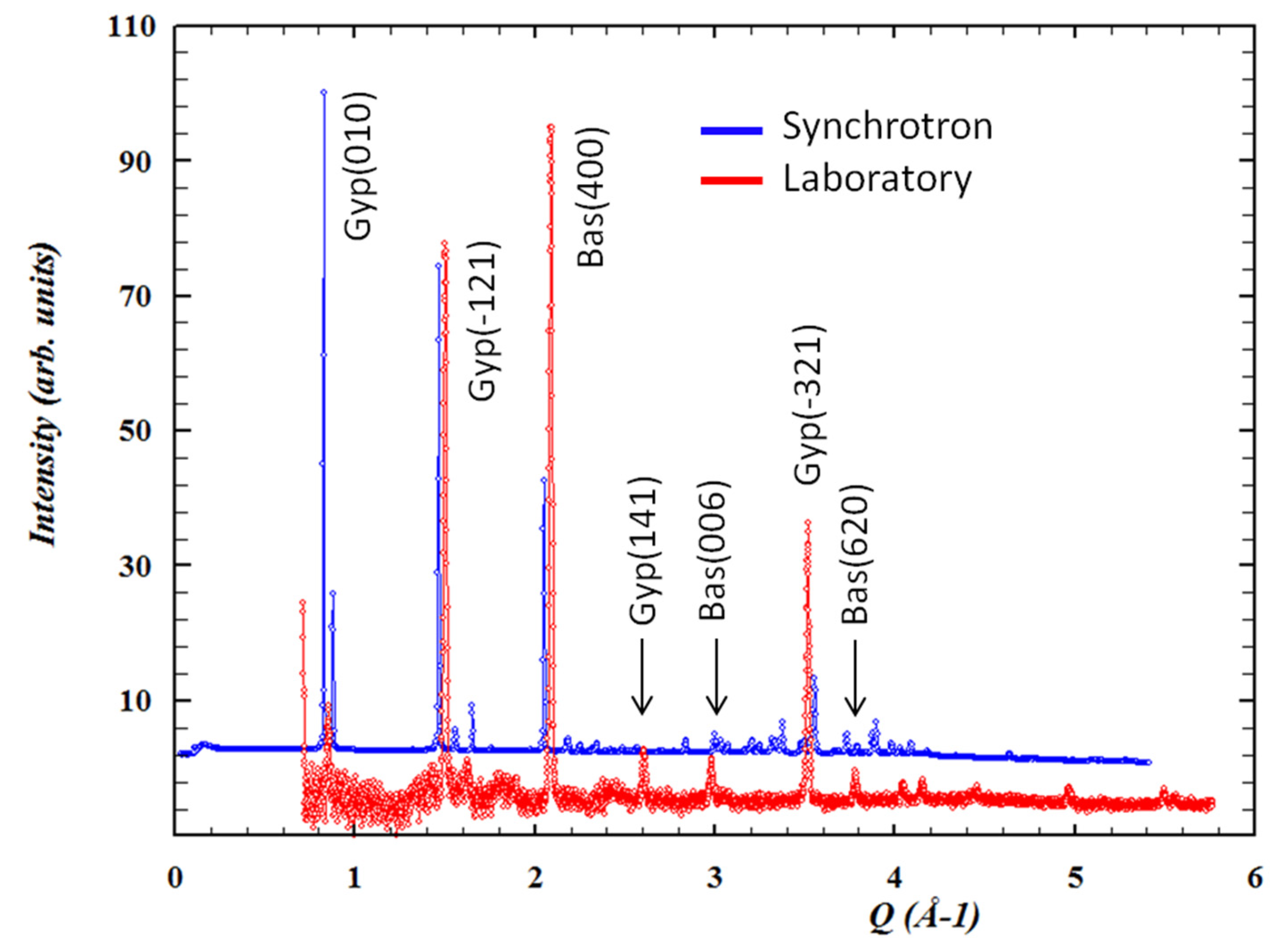

| Solute | Concentration (ppm) |
|---|---|
| Calcium | 1300 |
| Magnesium | 450 |
| Sodium | 100 |
| Chlorine | 51 |
| Silicon | 25 |
| Bicarbonates | 80 |
| Carbonates | 0 |
| Hydroxides | 0 |
| Sulfates | 1715 |
Publisher’s Note: MDPI stays neutral with regard to jurisdictional claims in published maps and institutional affiliations. |
© 2021 by the authors. Licensee MDPI, Basel, Switzerland. This article is an open access article distributed under the terms and conditions of the Creative Commons Attribution (CC BY) license (http://creativecommons.org/licenses/by/4.0/).
Share and Cite
Carreño-Márquez, I.J.A.; Castillo-Sandoval, I.; Pérez-Cázares, B.E.; Fuentes-Cobas, L.E.; Esparza-Ponce, H.E.; Menéndez-Méndez, E.; Fuentes-Montero, M.E.; Montero-Cabrera, M.E. Evolution of the Astonishing Naica Giant Crystals in Chihuahua, Mexico. Minerals 2021, 11, 292. https://doi.org/10.3390/min11030292
Carreño-Márquez IJA, Castillo-Sandoval I, Pérez-Cázares BE, Fuentes-Cobas LE, Esparza-Ponce HE, Menéndez-Méndez E, Fuentes-Montero ME, Montero-Cabrera ME. Evolution of the Astonishing Naica Giant Crystals in Chihuahua, Mexico. Minerals. 2021; 11(3):292. https://doi.org/10.3390/min11030292
Chicago/Turabian StyleCarreño-Márquez, Iván Jalil Antón, Isaí Castillo-Sandoval, Bernardo Enrique Pérez-Cázares, Luis Edmundo Fuentes-Cobas, Hilda Esperanza Esparza-Ponce, Esperanza Menéndez-Méndez, María Elena Fuentes-Montero, and María Elena Montero-Cabrera. 2021. "Evolution of the Astonishing Naica Giant Crystals in Chihuahua, Mexico" Minerals 11, no. 3: 292. https://doi.org/10.3390/min11030292
APA StyleCarreño-Márquez, I. J. A., Castillo-Sandoval, I., Pérez-Cázares, B. E., Fuentes-Cobas, L. E., Esparza-Ponce, H. E., Menéndez-Méndez, E., Fuentes-Montero, M. E., & Montero-Cabrera, M. E. (2021). Evolution of the Astonishing Naica Giant Crystals in Chihuahua, Mexico. Minerals, 11(3), 292. https://doi.org/10.3390/min11030292







